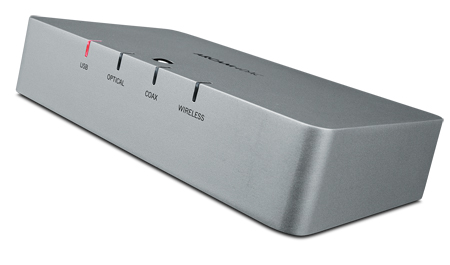What Hi-Fi? Verdict
No longer the default choice at the money, but a worthwhile contender nonetheless
Pros
- +
Compact and sturdy
- +
wireless convenience
- +
spacious, up-front sound
Cons
- -
Bass can be unruly
- -
sounds better hard-wired
Why you can trust What Hi-Fi?
For a brief moment, Arcam had the ‘affordable-DAC-by-a-venerable-hi-fi-brand’ sector all to itself with 2010’s Award-winning rDAC.
The rDAC is now under pressure from all directions, but it’s a measure of just how right Arcam got the original rDAC that this wireless variant is able to punch its weight against newer and more expensive alternatives.
This sturdy little box features the most important connections: optical and coaxial digital (24bit/192kHz compatible) and asynchronous USB inputs, and stereo RCA output.
Wireless connection requires either an rWave or rWand streaming dongle (currently around £60 each). Build quality is unquestionable, and the rDAC Wireless is finished impeccably.
Wireless convenience, hard-wired preference
The wireless aspect will appeal for all the obvious reasons, but there’s no denying the rDAC sounds its most effective when hard-wired to a source.
We used a MacBook for the bulk of our listening (along with our reference Naim NDX streamer) and for every genre of music, at every file size, the Arcam proved an adaptable and likeable device.
A 24/192 file of REM’s Country Feedback reveals everything that’s admirable about the rDAC. It’s a punchy, dynamic listen, with a definite emphasis on excitement.
That’s not to suggest it’s short on detail (it isn’t) but its real strengths concern scale, soundstaging and separation – what could, in lesser hands, be a congested recording has the space for individual instruments to stretch out.
Vocals, in particular, exist in their own well-defined space even as they’re smoothly integrated into the performance as a whole.
The competition is tough
Listening to rival units such as the Musical Fidelity M1DAC and Rega DAC, however, highlights the rDAC's relative lack of low-frequency finesse. Extension is impressive, and there's admiral tonal variation and texture, but where the leading edge bass notes is concerned the Arcam's just a bit vague.
It's similarly approximate when describing the decay of those same bass notes, and so sounds less than fully in control of low-end information.
This is far from a fatal flaw, but in the company of others it's a definite shortcoming. If the wireless aspect particularly appeals, though, the rDAC remains pretty compelling.
What Hi-Fi?, founded in 1976, is the world's leading independent guide to buying and owning hi-fi and home entertainment products. Our comprehensive tests help you buy the very best for your money, with our advice sections giving you step-by-step information on how to get even more from your music and movies. Everything is tested by our dedicated team of in-house reviewers in our custom-built test rooms in London, Reading and Bath. Our coveted five-star rating and Awards are recognised all over the world as the ultimate seal of approval, so you can buy with absolute confidence.


